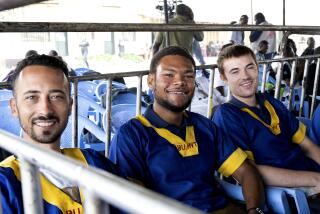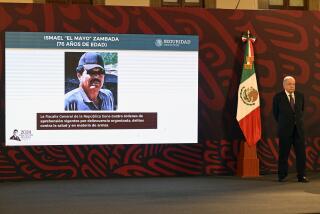U.S. Worried by Peace Corps Kidnaping : Philippines: The abduction may indicate a dangerous shift in the rebel campaign to shut U.S. military bases.
MANILA â The kidnaping of a U.S. Peace Corps volunteer, the first such act of anti-American terrorism attributed to Communist guerrillas here, may signal a dangerous new phase in the increasingly violent campaign to shut six U.S. military facilities in the Philippines, analysts said Sunday.
U.S. Embassy officials said several armed men took Timothy Swanson, 26, of Cheyenne, Wyo., from the remote Negros Island mountain village of Patag on June 13. They said his disappearance was not confirmed until Saturday.
The American officials said they had not heard from Swansonâs captors and were unsure of their motives. But there was widespread agreement Sunday that the kidnapers were almost certainly guerrillas of the Communist New Peopleâs Army.
Negros Island, 300 miles southeast of Manila, is a stronghold of the New Peopleâs Army, which has fought the Philippine government for 21 years in its campaign to set up a Marxist state here.
The U.S. officials repeatedly denied knowing of the abduction when they suddenly ordered the evacuation of all 261 Peace Corps volunteers in the Philippines last Wednesday. At the time, they cited intelligence reports that the New Peopleâs Army planned to kill or kidnap volunteers.
Although the officials said they learned only on Saturday of Swansonâs kidnaping, Bushâs national security adviser, Brent Scowcroft, said Sunday that the United States knew about it âclose to a week ago.â
One analyst who studies the NPA said Sunday that the abduction signaled a raising of the stakes in the rebelsâ drive to shut down the six American bases here.
âThe NPA view just about any American in the Philippines right now as fair game,â he said. Eight Americans have been killed in political violence here in the last 14 months.
All Peace Corps volunteers except Swanson were accounted for Sunday, said U.S. Embassy spokesman Stanley Schrager. About 200 have left for Hawaii since Friday, Schrager said, and the rest will fly out at dawn today.
President Bush, in a brief exchange with reporters after teeing off on a round of golf in Kennebunkport, Me., expressed concern about the kidnaping. âWell, that worries me. . . . The age of the terrorist--itâs not good.â
Schrager said several embassy aides rushed Sunday to the Negros Island provincial capital of Bacolod.
âThereâs no question in our mind that he was abducted by the NPA,â Schrager said. Fluent in the local dialect of Ilongo, Swanson spent more than two years in northern Negros, an impoverished sugar-growing area. A week after his abduction, guerrillas killed one militia member and four civilians in an ambush in Silay City, close to Patag.
Described by a friend here Sunday as âthe most laid-back dude you can imagine,â Swanson married a local schoolteacher in Silay City on May 29 and planned to spend a third year working in a local forest nursery.
âHe loved it up there,â said another volunteer. âHe never came to Manila.â
Father Antonio Fortich, the retired Roman Catholic bishop of Negros, said in a telephone interview from Bacolod that about four rebels went to Swansonâs home in Patag on the night of June 13.
âThis group told the wife, âWe would like to borrow your husband,â â said Fortich, who is known for contacts with the rebels. âHis wife said, âYou can talk to him here.â They said: âNo, the mountains are better. There it is very secluded and silent.â â
Asked what the rebels wanted, Fortich said: âThey said they wanted to talk matters over with him. They have many gripes against the government.â
As he was leaving, Swanson told his wife, Merle, ânot to say anythingâ to authorities so they wouldnât âblow up this newsâ and endanger his life, Fortich said.
She received a letter from her husband five days ago saying âhe is all rightâ and asking for books, underwear and eyeglasses, Fortich said. The rebels took the bundle during the night.
Fortich said Swansonâs wife finally told American officials of his abduction when they sent a notice from Manila announcing the evacuation.
âIt was a situation in which the people who knew about the abduction had been warned not to tell anyone,â one official said. âAnd they did not.â
Swanson was abducted about 15 miles north of where Fumio Mizuno, a training director for a Tokyo-based private aid organization, was kidnaped May 29. Mizuno, who had been in the country 10 years, has not been released.
Schrager and other officials said they do not know if the two abductions are linked. Fortich, who has tried to negotiate Mizunoâs release, said the kidnapers had dropped a demand for $250,000 ransom.
Negros has been the scene of bitter fighting between the NPA and the military. One government offensive last year, called Operation Thunderbolt, created an estimated 35,000 refugees, human rights groups charged. The NPA reportedly has about 1,000 guerrillas on the island.
The U.S. Embassy recently warned the 140,000 Americans living in the Philippines that they face an increased risk of terrorism when talks resume in August over the future of the U.S. bases. The analyst who studies the NPA attributed the kidnaping to the upcoming talks.
âThe NPA realize that they donât have the mass support to throw the bases out legitimately,â he said. âSo they turn to terrorism.â
The analyst said it was not clear, however, if the actual kidnapers were under orders from the rebelsâ general command or were a local NPA squad acting independently.
âWhat they want at this stage is a big question mark,â he said. âAnd why they snatched this guy is a bigger question mark.â
Muslim separatists belonging to a different guerrilla movement have kidnaped four Americans since 1979 on the island of Mindanao. All were freed unharmed.
The kidnaping of Swanson is believed to be the first such act by the Communist guerrillas.
Many Americans are increasingly nervous about anti-American violence in this former colony. Embassy employees, aid officials and business people now routinely use bulletproof vans, vary their driving habits and avoid public places. One group of international bankers recently was careful not to leave its Manila hotel for fear of violence.
âPeople are more tense,â said Mark Blacker, head of the American Chamber of Commerce here. Two American businesses recently were threatened, he said, but he would not identify them.
More to Read
Sign up for Essential California
The most important California stories and recommendations in your inbox every morning.
You may occasionally receive promotional content from the Los Angeles Times.











